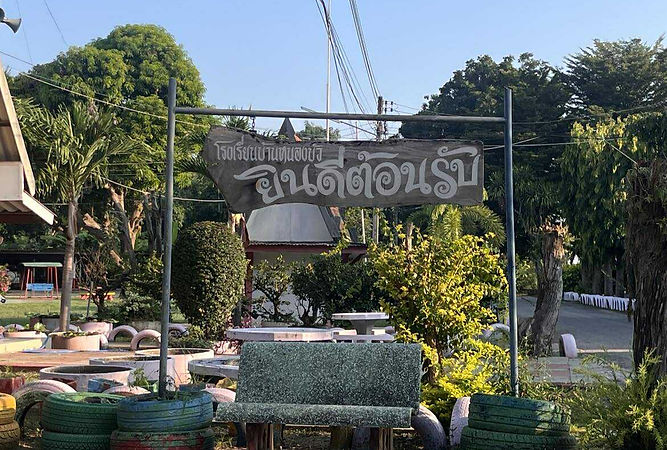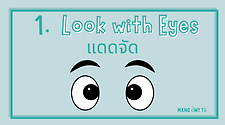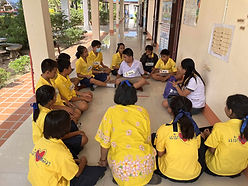

Teaching Practice
A plan will never be successfully realized without teacher’s skills, flexibility and management. With this, lesson plan is not the sole determiner of a lesson’s success.
This page outlines my teaching procedures, classroom management techniques, and problem-solving strategies at Ban Nong Bua School. In this blog, I will share my experiences on my first teaching demo at the aforementioned school, as well as the final, to demonstrate growth and learning acquired during the process.
Just a week after my arrival, I already insisted on teaching a topic given that I believed I already observed what I needed to. My topic was about weather, specifically sunny, windy, cloudy, rainy, and snowy. I pondered deeply how would successfully teach them despite several barriers including the most difficult one: communication.
How would you teach students who know only little about the language you use as a medium of instruction? It’s quite difficult, right? However, with an effective strategy and some help from others, it would be realized.
The first thing that came into my mind was the use of visual aids in order to connect to students despite the language and communication barriers. I tried to utilize pictures that clearly depict the topic that I will be teaching. Another thing, I thought of was why not use subtitles in my PowerPoint Presentations. I believe it would be an effective tool— to connect the vocabulary being taught to their language 1 or the mother tongue because only through this way they be able to understand better the vocabulary that is being taught to them. I also tried my best to incorporate actions while I was teaching because I believe verbal communication would be better enhanced by adding non-verbal ones. Lastly, I tried to utilize materials that would allow them to utilize their senses such as feel, touch, hear, or even taste. I do believe that once they experience it, it will provide a better learning experience.
1st Teaching Demonstration
Preliminaries
.png)
.png)
.png)
.png)
.png)
After the rules, I proceeded with the motivation part in which I chose to let them dance as a way of energizing them and at the same time providing them an idea about our topic. I utilized a video from Youtube which is a dance and actions about different weathers. Each weather, it has a corresponding action which I think would be helpful for the students to remember and understand what each word/weather means. Below is the link to the YouTube video that I used. I played it and let them dance 3 times in order for them to have mastery and at the same time, to have ample time to realize what the video implies.
Analysis


After that, I proceeded to the main part of the discussion. In this phase, I aimed to make the activity as creative and engaging as possible to give the students an explorative learning experience. Instead of following the plan, which originally suggested exploring inside the classroom, I decided to conduct the gallery walk outside. This way, the students wouldn’t feel confined within the four walls of the classroom but could also enjoy the fresh air while learning. I prepared five posters and pasted them on the wall outside, with each poster representing a different type of weather.
Before we began, I distributed “boarding passes” to each student to make the activity more exciting and immersive. This little detail helped them feel as though they were embarking on a journey to “experience” different types of weather. I also gave clear instructions on how the gallery walk would be conducted to ensure everyone understood the process.
During the gallery walk, we “traveled” to different stations. At each one, the students observed the poster and guessed what type of weather it represented. For example, at the sunny station, they identified the poster and pasted the correct picture of the sun. Then, I let them feel the warmth of the sun to deepen their understanding. Afterward, they read a short sentence containing the word “sunny,” such as “It is sunny today.” We repeated this process at each station—feeling the rain through the spray bottle, the snow using the ice, the wind with the fan, and the clouds using the cotton.




Application
Afterwards, I asked them to answer the prepared worksheet, which served as an assessment of their learning. This provided a measurable way to evaluate how well they understood the concepts discussed in the lesson. To wrap up the session, I asked a few checking questions to assess their comprehension further. Some of these questions were connected to their everyday experiences, such as identifying the type of weather we were having that day.
I strongly believe that effective questioning plays a vital role in gauging students’ understanding and reinforcing meaningful learning.


I started my lesson with greetings and asked for their current mood. In this way, they will be able to be aware of their current emotional state and I know it would start the development of connection and trust between me, the teacher, and them, the students. This could be of great start in developing the connection that would help in making teaching and learning effective. Next, I provided the rules. This part is what I always give attention to even when I am in the Philippines. A rule must be implemented in order for a classroom to be managed. It will provide the students guide on how to behave and what they should and not do. Establishing rules at the start of the discussion or even at the start of a school year could be of great help for a teacher to eliminate misbehaviors and not waste time on the succeeding days to correct misbehavior. The rules I used were just those simple to remember. I utilized basic body parts such as eyes, ears, mouth, and hand— Look with eyes, listen with ears, zip the mouth, and raise hand if wanted to answer or to talk. I chose to use body parts in my rules so that when I remind them in any part of the lesson when they disobeyed a rule, I will just point to the body part. I also made sure that they understood everything and that they agreed with it. Because if students don’t agree with the established rules, it will surely not be that effective.
Motivation / Activity
After the preliminaries, I proceeded to the analysis part of my 4As Strategy Lesson Plan. I posted pictures of sun, clouds, rain, wind, and snow. After pasting, I asked them to describe it, and if they see the connection with the video presented as motivation. While asking, I utilized the most simple words as possible, and provided them guide/prompt in answering such as “I observe that ____”. I also seek for help of my cooperating teacher in translating in case they don’t understand.
Abstraction


In addition, I prepared photos of the sun, clouds, rain, wind, and snow for the students to paste on the corresponding posters. This hands-on activity allowed them to connect visuals with the weather concepts being discussed.


To make the experience even more sensory and interactive, I prepared additional materials for each station. For the sunny weather, the students could feel the warmth of the actual sun outside. For the windy weather, I used a fan to simulate the breeze. To represent rain, I used a spray bottle with water so they could feel droplets on their skin. For clouds, I provided soft, cloud-shaped cotton for them to touch, and for snow, I placed ice in my tumbler so they could experience its coolness.
Lastly, I used a stamp system as an additional motivation and reward. After successfully completing each station by identifying the weather and reading the phrase correctly, the students earned a stamp on their boarding pass. Once they collected all the stamps, they received a reward at the end of the lesson, which made the experience more exciting and memorable.
After the lesson, I proceeded with the application part by letting the students play a game of charades. This time, they didn’t just guess individual words but also the phrases they had learned during the lesson. This activity encouraged them to recall, apply, and demonstrate their understanding in a fun and interactive way.
Evaluation



On my second and final demonstration, I once again applied the 4A’s teaching method. Building on my learnings and realizations from my first demonstration, I made a conscious effort to improve in areas where I felt I needed growth—one of which was time management. During my first demo, my eagerness to provide fun and meaningful learning experiences led me to extend beyond the expected time. For this final demonstration, I became more mindful of pacing, ensuring that every activity was planned and managed effectively.
Final Teaching Demonstration
Preliminaries
To make the lesson engaging, I introduced the food vocabulary through a picture-matching game. I pasted pairs of food photos on the board in random order, with the pictures facing down so the students couldn’t see them. They took turns flipping two photos at a time to find a match. If the photos didn’t match, they flipped them back and let another classmate try. The activity encouraged teamwork, observation, and memory recall while sparking excitement for the topic.
Next, I used a PowerPoint presentation for a game called “Guess the Food.” The slides contained the same pictures used in the matching game along with letter clues. The students had to guess the name of the food using the hints provided. This simple but interactive activity served as the introduction to the new vocabulary words.
Analysis
For the next part, I conducted a sensory exploration activity outside the classroom to make learning more experiential. The students sat in a semi-circle on the hallway floor while I introduced different foods representing various tastes. One by one, I showed the food items and let the students taste them.
Application
For assessment, I distributed a worksheet designed to measure the students’ understanding of the topic. At the end, I also asked real-life-related questions such as:
-
“What is your favorite taste?”
-
“What is your favorite food?”
These reflective questions allowed me to assess not only their comprehension but also how they could relate the lesson to their personal experiences.











I followed the same routine as my first demonstration: greetings, presenting the classroom rules (which remained the same so students were already familiar with them), and conducting an icebreaker activity. For motivation, I used the popular song-and-dance video “Head, Shoulders, Knees, and Toes.”
I chose this because, during their morning assembly, the students had been learning vocabulary related to body parts. I thought it would be a great way to integrate and connect their prior knowledge to my lesson on “Taste.” After the dance, I conducted a quick pointing activity: I called out body parts, and the students had to point to them. When I said “mouth,” I smoothly transitioned into my lesson by asking, “What do we put inside our mouths?” The students thought for a moment and replied, “Food!”—a simple yet effective way to introduce the topic.
Motivation / Activity


After each correct guess, I asked the students to describe the food using attributes like texture, taste, color, or any other descriptive words they preferred. I also asked them whether the food was healthy or unhealthy, integrating a short discussion about health and making healthy choices. This allowed students to practice using descriptive language while developing values related to wellness.
Abstraction
Each time they tasted a food, I introduced the corresponding vocabulary for the taste and guided them to form sentences combining the food name and its taste. For example:
-
Sweet – cookie
-
Sour – sour candy
-
Salty – nuts
-
Spicy – chips
This activity kept the students highly engaged and made learning memorable since it connected new words with real-life sensory experiences. The use of actual food not only served as motivation but also became an effective tool for exploratory learning.
I chose to incorporate this strategy again because I observed its effectiveness in my first demonstration. Allowing students to learn through their senses made vocabulary easier to understand, retain, and apply.
For the application activity, I divided the students into four groups. To save time, I assigned the groups beforehand and arranged their seats so that when we returned from the hallway, the students knew exactly where to sit.
I displayed pictures of different foods on the screen, and each group had to analyze the food’s taste and write their answer on a piece of paper within 10 seconds. This time limit added excitement to the activity and helped manage pacing. After counting from one to three, the first group to raise their hand went to the front, read their answer, and used it in a sentence. The game continued until all the tastes were covered.
Evaluation

This teaching demonstrations strengthened my belief that teaching is also learning. Every teaching and learning situation presents new challenges and opportunities for growth—not only for students but also for us, as teachers. Through this experience, I learned that effective teaching requires adaptability, creativity, and constant self-reflection. I realized the importance of being open to continuous learning. As educators, we must embrace the idea of being lifelong learners because there will always be new strategies, experiences, and knowledge to explore. By learning alongside our students, we also grow—not just in our knowledge and skills, but also in our values and practice as future educators.



